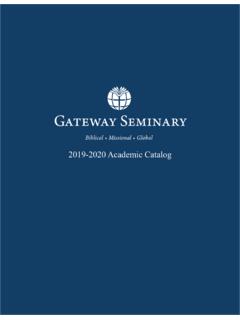Transcription of ADDIS ABABA UNIVERSITY SCHOOL OF GRADUATE …
1 ADDIS ABABA UNIVERSITY SCHOOL OF GRADUATE studies department OF biology Infection prevalence of ovine fasciolosis in irrigation schemes along the Upper Awash River Basin and effects of strategic anthelmintic treatment in selected upstream areas By MICHAEL ASRAT In the partial fulfillment of the requirement for the attainment of the degree of Master of Science in biology (Biomedical Science) ADDIS ABABA December 2004 TABLE OF CONTENTS List of List of I.
2 1. General accounts and 2. 3. Clinical 4. Pathology and 5. 6. Control and 7. Importance of ovine II. 1. General:..23 2. Specific:..23 III. Materials and 1. The study 2. 3. Study 4. Data Management and statistical VI. 1. Fasciolosis infection 2. Feacal egg 3. Snail 4. Effects of strategic anthelmintic 5. Economic benefits of strategic anthelmintic V. VI. i List of Tables Table 1. Anthelmintic for the treatment of liver Table 2. Sample collection time with respect to agro-ecological zones, age and 3. Feacal egg output (mean ) by altitude, season, grazing land, age and sex in ovine fasciolosis (November 2003 October 2004) (n=729).
3 44 Table 4. Summary findings on feacal egg output EPG (mean ) by altitude, season and grazing land in the Upper Awash River Basin (November 2003 October 2004)..45 Table 5. Survey of snail fauna in the Upper Awash River Basin (November 2003 October 2004)..47 Table 6. Habitat preference and density of snails (snail/m2) in different agro-ecological zones in the Upper Awash River Basin (November 2003 October 2004)..47 Table 7. Measurement of some indicator parameters of experimental animals subjected to strategic anthelmintic trial (November 2003- October 2004).
4 48 Table 8. Description of and cause for exclusion of some animals from the 9. Economics benefits of strategic treatments calculation based on mean live weight gain difference (November 2003- October 2004)*..52 ii List of figures Figure 1. Adult stage of Fasciola Figure 2. Rumen and liver fluke Figuer 3. Lymnaea spp. a) and b) L. natalensis; c) L. columnella; d), e) and f) L. 4. Life cycle of Figure 5. Map of Ethiopia showing the Awash River Figure 6. Map showing the location of the study Figure 7. Monthly rainfall (mm), mean relative humidity, mean maximum and minimum monthly air temperatures (oC) of Holeta area for the period from August 2003 to July Figure 8.
5 Monthly rainfall (mm), mean relative humidity, mean maximum and minimum monthly air temperatures (oC) of Debre Zeit area for the period from August 2003 to July Figure 9. Monthly rainfall (mm), mean relative humidity, mean maximum and minimum monthly air temperatures (oC) of Melkasa area for the period from August 2003 to July Figure 10. Monthly rainfall (mm), mean relative humidity, mean maximum and minimum monthly air temperatures (oC) of Nura Era area for the period from August 2003 to July Figure 11.
6 Distribution of ovine fasciolosis by grazing lands and seasons in the Awash River Basin (November 2003 October 2004) ..39 Figure 12. Distribution of ovine fasciolosis along different agro-ecological zones and seasons in the Awash River Basin (November 2003 October 2004)..40 Figure 13. Distribution of ovine fasciolosis along different Agro-ecological zones and grazing lands in the Awash River Basin (November 2003 October 2004)..41 Figure 14. Mean feacal egg count of one time and two times anthelimnithc treated and control groups of expermintal sheep in Wolemera area (November 2003- October 2004).
7 49 Figure 15. Mean PCV of sheep following one and two time anthelmintic treated and control group of expermintal sheep in Wolemera area (November 2003- October 2004)..50 Figure 16. Mean body condition score of one-time and two-times treatment anthlementic treated and control groups of sheep in Wolemera area (November 2003- October 2004)..51 Figure 17. Difference in body weight gain between animals subjected to different strategic anthelmintic treatment iii Acknowledgments I want to express my sincere thank to Drs.
8 Beyene Petros, Yilma Jobre, Don Peden, Yoseph Shiferaw and Girma Taddesse, my research advisors, whose help from the beginning to the end of this project was very substantial. I am very much indebted for their maximum cooperation for providing research facilities and for their encouragements. The inputs they provided at various phases of this work and through correcting the thesis were very valuable. My heart felt gratitude is extended to Drs. Zinashe Sileshi and Azage Tegene for their help and strong moral support. My sincere appreciation is also extended to the SCHOOL of GRADUATE studies (SGS), ADDIS ABABA UNIVERSITY (AAU) and International Water Management Institute (IWMI), International Livestock Research Institute (ILRI) for their financial supports and the Ethiopian Agricultural Research Organization (EARO) for the provision of laboratory facilities at Holeta Agricultural Research Centre.
9 I would like to express my thanks to Mr. Mulugeta Mamo, W/o Tigist Mamo, Mr. Senai Assefa and Mr. Wondimu Tilahun for their strong moral support, useful and constructive suggestions throughout my research work. I am also particularly grateful to Mr. Ashebir Abegaze, Mr. Diriba Hunde, Mr. Hailu Getu and DA s at the four study sites for there all rounded assistance and their time during data collection and laboratory analysis. My words of acknowledgement are due to Dr. Yalemetsehaye Mekonenn, Professor Tesfu Kassa, Mr.
10 Birhanu Erko, Mr. Girmay Medhin, all at the Institute of Pathobiology; and ILRI staff (at Capacity Strengthening Unit, Agro-ecosystem and Natural Resource project, and Partnership and Communication unit), EARO staff (National Animal Health Research Center, and Soil Laboratory and Nutrition department ) and AAU staff (secretaries at the department of biology and other staff) for diverse and valuable contributions. The assistances obtained from Mr. Medahni Asemelash and Mr. Akiliu Bogale during statistical analysis of the data was greatly valued.










